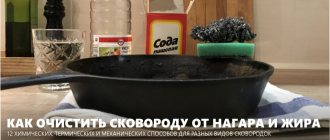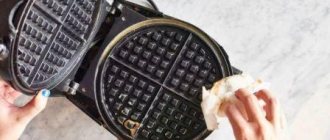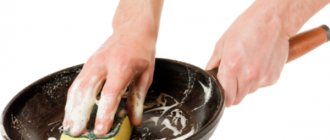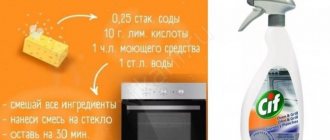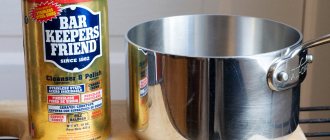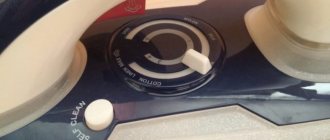What to do if a stainless steel pan becomes very dark due to overheating? How to clean a pan that has burned? Cleaning a burnt pan from scorching with soda and vinegar at home. Tips for cleaning metal pans from burnt and scorched areas at home.
It is impossible to be a perfect cook and never make mistakes while preparing food.
How to clean a burnt stainless steel pan
Stainless steel cookware is durable, inexpensive and very practical; it is used everywhere in every family. But over time, such dishes lose their appearance and darken, and due to frequent use, traces of soot, blackness and dirt remain on them, which cannot be cleaned.
How to remove these traces? Effective and time-tested folk methods will help.
Advantages of stainless steel pans
Stainless steel pans are loved by many housewives. This cookware looks beautiful and expensive, and its shiny surface attracts the eye and creates a feeling of cleanliness and order in the kitchen at home.
If carbon deposits settle on the outside of the pan, it creates the impression of sloppiness in relation to cleaning dishes and cleaning the house.
In addition, stainless steel is a durable and reliable material, ideal for cookware with frequent use. Such a pan is strong, durable and can last for more than one generation of housewives, especially with proper care and proper use.
Light stains on the pan can be removed with detergents.
General recommendations for removing carbon deposits
Before you start practicing, it is useful to study the theory. Please note that removing carbon deposits is based on three postulates.
- We take into account the material from which the pan is made. Products suitable for enamel may not “like” products made of stainless steel or aluminum.
- A. The more burnt the pan is, the more powerful methods may be required.
- We begin the fight against carbon deposits as early as possible. Fresh stains are much easier to remove, so don’t put off cleaning dishes for too long. If you don’t have time at all, you need to at least pour water into the bottom and drop a little detergent.
To prevent the burning smell from spreading throughout the apartment, you need to cover the burnt pan with a wet towel.
"Whims" of different materials
The specifics of cleaning a pan are dictated by the characteristics of the material from which it is made.
If an aluminum pan is burnt, you should not use the following to clean it:
- metal sponges and scrapers - they scratch the bottom and walls of the product;
- caustic chemicals - aluminum can react with them, and the vapors released are dangerous to human health.
When cleaning practical stainless steel pans you need to:
- refuse metal scourers - so as not to damage the shiny surface of the dishes;
- forget about aggressive chemicals - to prevent the formation of dark spots;
- carefully study the composition of the detergent composition - it should not contain ammonia and chlorine.
To clean an enamel pan from burnt food without harming the appearance and functionality of the product, you should avoid:
- temperature changes - before soaking the pan, you should wait until it cools down, since contact of cold water with a hot bottom leads to peeling of the enamel;
- metal sponges - hard devices scratch the surface.
How to clean a burnt stainless steel pan at home
Over time, scale, burnt marks, dark spots and rings, blackness, and old grease appear on a metal pan. All these contaminants not only do not decorate the dishes, but also lead to their rapid deterioration.
Let's look at how to clean a burnt stainless steel pan, and what cleaning methods exist for different cases.
Using apple peel
Sour green apples, namely their peel, will help quickly restore the shine to stainless steel. It is necessary to peel several apples and boil them in plain water in a burnt pan for half an hour.
But if the soot is very old, you will have to boil the peel several times. For greater efficiency, it is recommended to add a little table vinegar to the broth when boiling.
Folk methods for cleaning a shiny pan from the outside and inside from burning
The best way to easily clean the inside of an old or burnt stainless steel pan is to boil it. Boiling water will help to effectively clean the inside of dishes and even get rid of very old dirt, soot and greasy deposits.
Minor stains on a stainless steel home pan that arise during the cooking process can be easily removed with a mild detergent.
For greater efficiency, it is worth adding soda and salt, laundry soap, and vinegar to this water. This method effectively removes dirt and helps restore shine and cleanliness to the pan.
Heating with salt
Another effective “grandmother’s” way to effectively clean a dirty stainless steel pan at home is heating it with salt. This type of cleaning is effective for cleaning the inside of the saucepan and for light soiling.
Salt will help get rid of many impurities.
If the contamination is strong and overheating with salt does not help, you can add soda, soap and water in addition to salt, and boil for an hour. This procedure will definitely be effective.
How to clean the bottom using boiling
The dirty bottom of the saucepan can be easily washed by boiling. Pour water into it and add baking soda, grate a piece of laundry soap and add table salt.
Boil the mixture for an hour; you can soak the dishes in the solution overnight.
There is no need to clean or scrub; after this procedure, all dirt, carbon deposits, grease and soot will disappear after a simple wipe with a sponge. Boiling is effective even with old stains and burnt sugar or burnt jam, which is so difficult to remove.
Clean with activated carbon
A good method to clean burnt stainless steel dishes not only from the inside, but also from the outside is activated carbon. It absorbs dirt and grease well, leaving you clean and shiny.
You can get rid of accumulated carbon deposits by using activated carbon.
You need to crush a couple of packs of coal in a mortar and mix with water to form a thick mass. You can use a blender, only then you will have to wash it thoroughly. This mixture should be used as a regular detergent: apply to a sponge and wash dishes.
Remove carbon deposits with whey
If food is burnt inside the saucepan or the dishes are blackened, an excellent cleaning method is whey or sour kefir. The acid in the dairy product dissolves old grease and dirt and helps achieve complete cleanliness.
Whey is one of the effective means of cleaning dishes.
Pour whey or kefir into a saucepan and leave overnight, and in the morning boil with clean water and simply wash with a sponge.
Cleaning with soda and vinegar
If your pan is burnt, do not rush to clean it with harsh cleaning agents: you may damage the metal. You can wipe off dirt and burnt marks with home remedies: vinegar and soda.
Using vinegar, dishes can be cleaned until they shine.
A solution of vinegar or soda should be used separately. Vinegar is effective if you need to remove old fat - acid dissolves it perfectly. Soda works well with scale, soot, soot and lime. In both cases, you need to make a solution and boil for an hour, then wash with detergent or soap.
We use soap
If food is burnt or milk is burnt, laundry soap will help clean it. Grate a bar of soap on a coarse grater, add a couple of tablespoons of soda and boil this solution for an hour and a half, adding water if necessary.
One of the best ways to clean dishes is to use soap.
The solution will turn black because all the dirt will come off the dishes. After boiling, scrub the dishes with a hard sponge and rinse with water.
Cleaning a burnt pan with citric acid
Citric acid is an effective tool for removing burnt marks and old fat from stainless steel. A tablespoon of acid will do per liter of water; you can also add vinegar for greater effect. If the contamination is not severe, or the metal has become tarnished, you can wipe the dishes with a sponge soaked in an acidic solution.
Citric acid will help get rid of soot and scale.
If the inside and outside are heavily soiled, you should boil the pan in this acidic solution, and then wash off the remaining dirt with water and detergent.
How to clean stainless steel with baking soda and hydrogen peroxide
Burnt and scorched marks will go away if you use baking soda and peroxide. Instead of peroxide, you can use ammonia. A few drops of the product, water, a pack of soda - and the detergent is ready. If there is strong burnt soot, you should soak the dishes in this solution overnight and then boil for half an hour.
This method can be used for scale and old stains both outside and inside the pan.
Removing carbon deposits from coffee grounds
If your cookware is dark or dull, use coffee grounds. The main thing is not to rub too much so as not to scratch the metal surface.
You can get rid of accumulated carbon deposits by using activated carbon.
Brew coffee or simply pour boiling water over it and leave to swell for 10-15 minutes. Then rub the surface of the dishes with this thickener using a sponge with light movements, without excessive pressure. After this procedure, the dishes shine like new.
Cleaning stains with office glue
The original “grandmother’s” method of cleaning dishes is with stationery silicate glue. It adds shine, removes darkened layers and scale and returns the dishes to their original appearance.
Mix glue with water and soak the dishes in this solution for a couple of hours.
After this, wash the pan with vinegar or citric acid and rinse in running water. Your pan is like new!
How to clean a saucepan with household chemicals
To remove old dirt and grease from the walls of a pan, not only traditional methods, but also modern detergents will help.
After use, it is necessary to wash the pan in a sufficient amount of running water with the addition of a gentle detergent.
Abrasive powders are dangerous because they can scratch metal surfaces, but they can be used as a solution by mixing with boiling water. In this case, they are quite effective.
Proper washing will prevent unsightly dark spots and streaks from appearing on the walls and bottom of dishes.
Cream products show good results, especially if you soak stains with them. But with heavy soot they are not always effective.
Useful tips for the care and prevention of stainless steel pans
When using stainless steel cookware, follow simple rules.
- Wash dishes immediately after use to prevent dirt from being absorbed into the metal surface.
- If something is burnt or stuck, immediately soak it in water, boil it and wash it, do not leave it like that.
- Wash dishes thoroughly and always with detergent, even if they need to be rinsed lightly. Contamination is often invisible to the eye and appears gradually.
- Always wash the outside of the saucepan thoroughly, paying special attention to the bottom, handles, folds and depressions - where old dirt most often accumulates.
- Try to take care of the dishes, do not scratch them with metal spoons, and do not put them on too high a fire.
Keep your cookware clean and take care of it, and it will serve you for many years!
Toothpaste and ammonia
When using this cleaning method, you should follow safety precautions - wear rubber gloves and a respirator, or at least a gauze mask, so as not to inhale heavy vapors of ammonia.
First, you need to squeeze out mint toothpaste onto a cloth, and pour ammonia on top of it. Then the stain is vigorously rubbed with the prepared mixture and left for 30 minutes. After cleaning, rinse the pan thoroughly and then rub it with a dry cloth until shiny.
There are many folk recipes that, without the use of aggressive household chemicals, will help keep kitchen utensils perfectly clean and remove even heavy carbon deposits from stainless steel.
